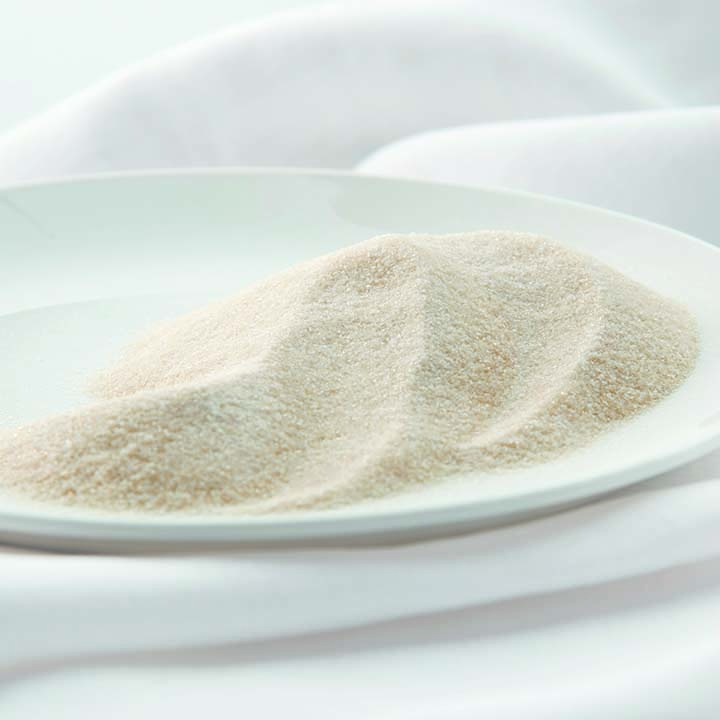Everything you need to know about using agar-agar, the wonder setting agent that’s super stable and vegan-friendly.
What is agar-agar?
Agar-agar (also known as agar) is a natural gelatinous substance obtained from a Southeast Asian species of red seaweed. It is most commonly used as a vegan-friendly alternative to gelatin in baking.
The gelling property of agar was discovered in Kyoto in 1658 when, according to the legend, an innkeeper discarded leftover seaweed soup in the snow and noticed it was gelled up the next morning. Nowadays, agar has many roles in the culinary world like setting savoury gels and jellies on modernist plates, thickening low-sugar jams, or creating creamier ice creams. However, it’s most commonly used in Asian sweets and desserts, like the viral raindrop cake.
Forms of agar-agar
Agar exists in three main forms: powder, flakes and strands. Powdered agar is by far the easiest to use as it dissolves quite easily. It is also the easiest type to find. For these reasons, the information in this article is based on the powered variety.
Agar is also available in hard, plastic-like strands which, when ground, give you agar flakes. These forms are harder to work with as they have to be softened in cold water and then boiled for a while to dissolve completely.
Special characteristics of agar-agar
Although a great substitute for gelatin, agar has its own unique properties.
- Vegan: Gelatin is made from animal collagen, while agar is extracted from a variety of seaweed. This makes it an appropriate substitute for vegetarian and vegan diets.
- Blank canvas: Without any distinct taste, odour or colour, agar can safely be used in desserts and other cooking without altering the taste or smell.
- Firmer texture: While gelatine has a more jiggly, melt-in-your-mouth feel, agar jellies are firmer and have a ‘bite’ to them.
- Sets at room temperature: Agar is far more powerful than gelatin. It can completely set at room temperature and also keeps its shape on warmer days without fear of melting or collapsing.
How to use agar-agar
- HYDRATE: Whisk the agar powder into room temperature liquid (water, fruit juice, tea, stock). Don’t use hot water as it will cause the agar to clump.
- BOIL: Bring mixture to a rolling boil. Boil for 5-10 minutes or until the agar-agar is completely dissolved. This boiling step is important as agar-agar activates at 90ºC. Do not boil for longer than needed as this may affect its gelling abilities.
- MOULD: Pour agar mixture into your mould(s), working quickly before it sets. You do not need to grease, line or oil your moulds.
- SET & CHILL: Set the moulds at room temperature, making sure not to disturb the mixture too much during this time. Agar-based desserts are best served cold, so chill in the fridge for a few hours before serving.
Note: For cases when the mixture you want to be set cannot be boiled for so long (e.g. milk for a milk jelly), you’ll need to activate the agar in a small amount of water, then mix into the warmed liquid (in this case, milk) – makes sure it’s warm as this will prevent the agar from instantly setting when it makes contact.
How much agar-agar powder should I use?
Follow the package instructions or recipe to determine how much agar powder to use. Because it is stronger than gelatine, it cannot simply be substituted 1 for 1. As a general rule of thumb, 1 tsp agar will firmly set 1-1 ⅓ cups liquid. Use slightly less for a softer set or jam-like consistency.
To test whether your mixture will set properly, drop a small amount on a cold plate. If it doesn’t set within 30 seconds, add more agar (or alternatively add more liquid it’s too firm).
If you’re unhappy with the firmness of the set, agar-set items can be magically remelted without compromising their gelling abilities (unlike gelatin).
Take note that acidicidy affects the gelling strength of agar so will require a higher amount. Certain raw tropical fruits, like kiwi, papaya, pineapple, mango and guavas contain an enzyme that prevents agar from setting entirely. If you want to use these fruits, heat them to a low boil before using to deactivate the enzyme; tinned fruit juices can be used as an alternative as heating is part of the pasteurisation process.
Where can I find agar-agar?
Agar can be found in health food stores, although it tends to be fairly expensive there. First have a look at your closest Asian or Indian speciality shops. Take note that agar is rather known as ‘kanten’ in Japanese stores. You may also be able to find agar-agar in supermarkets that carry health food lines.
Photograph by Graeme Borchers
ALSO SEE: How to make vegan mayo


